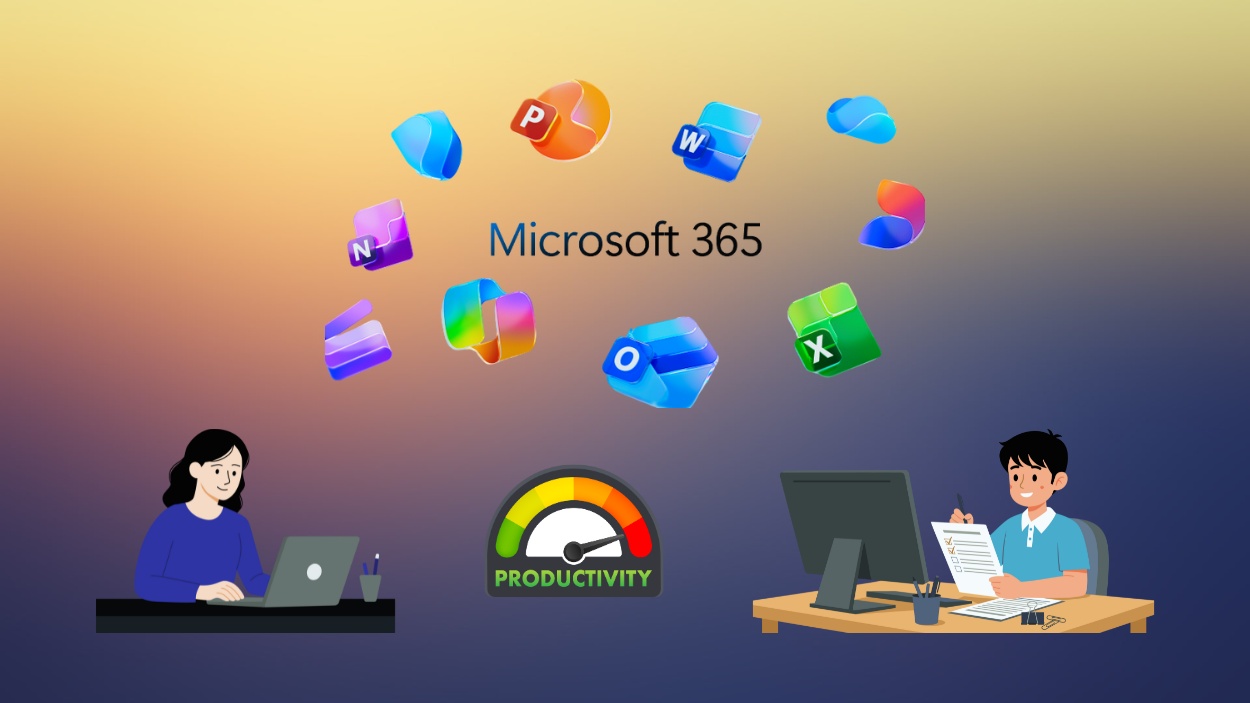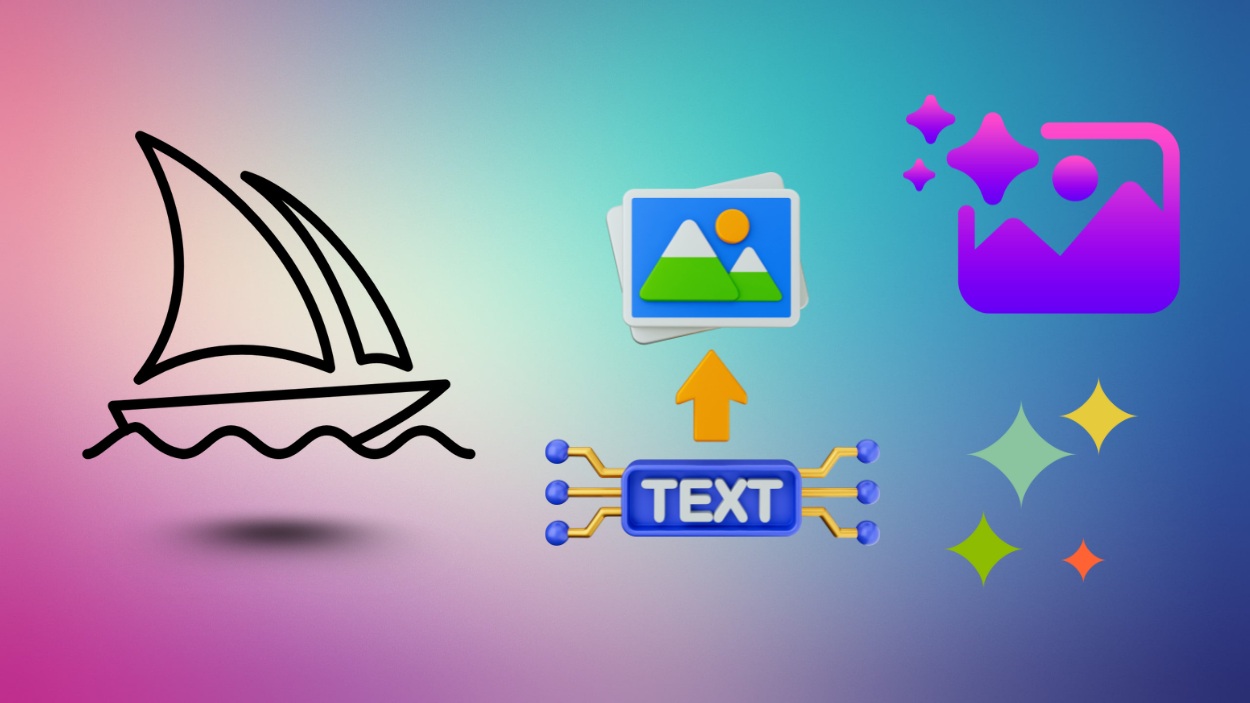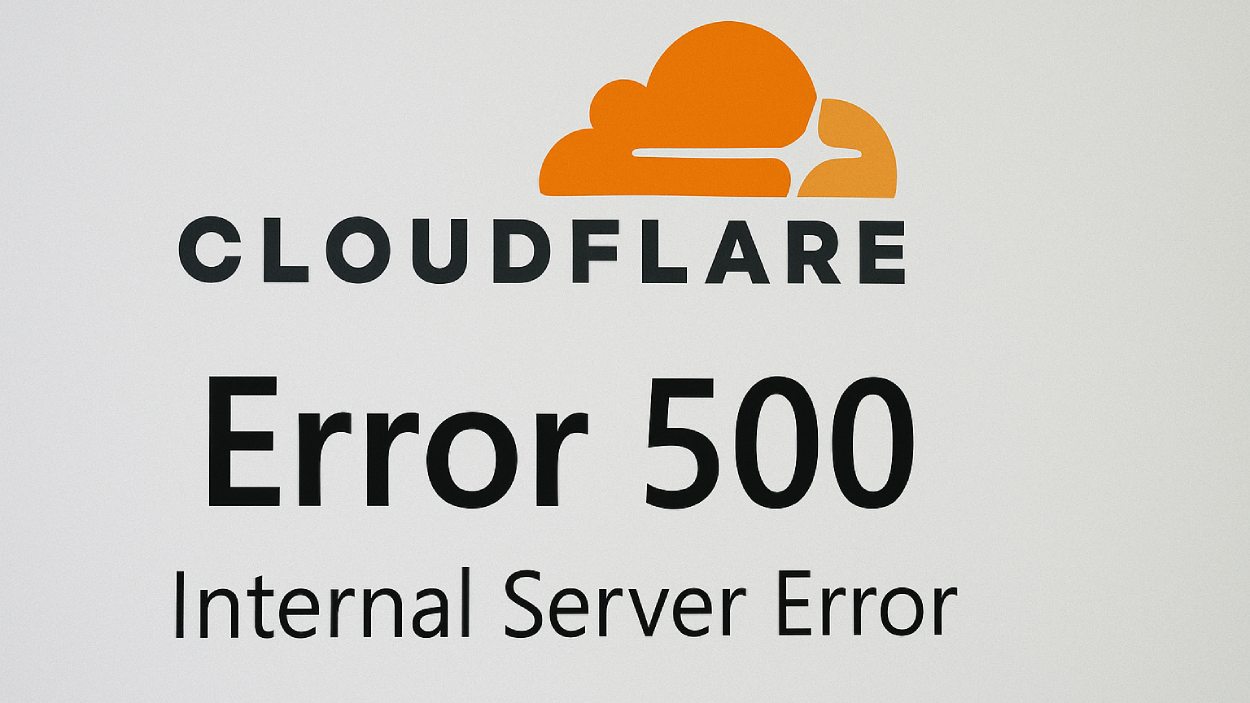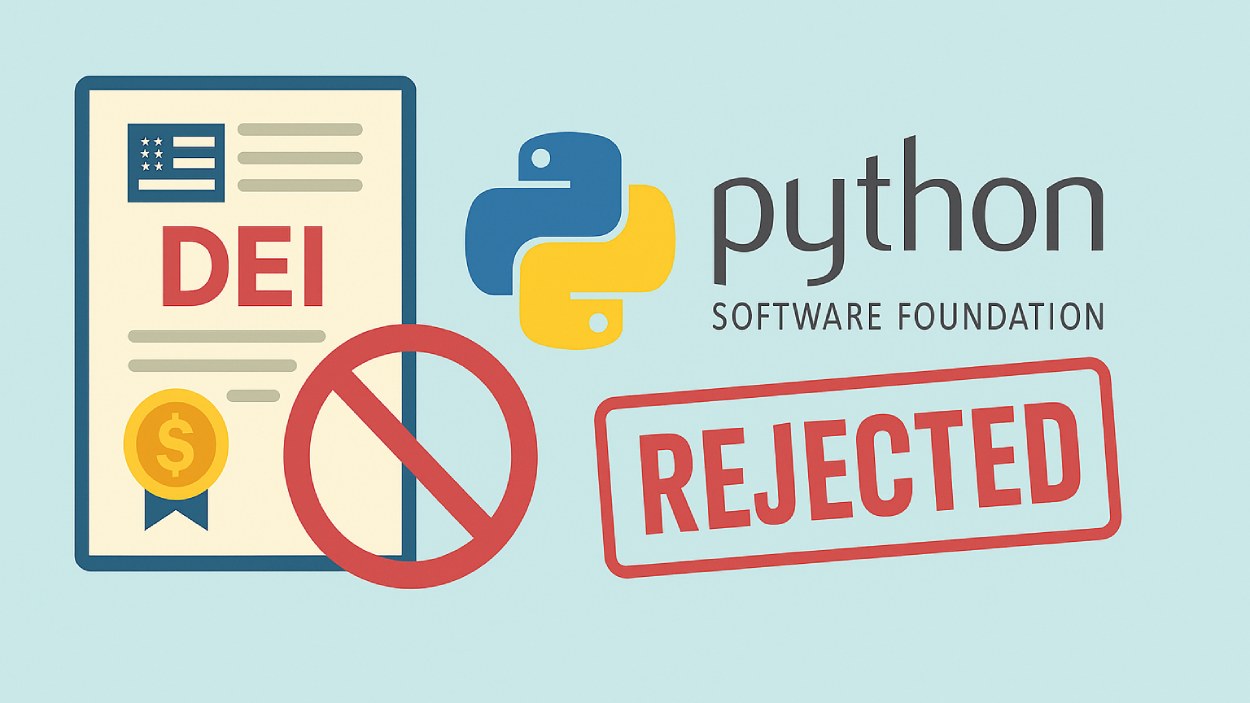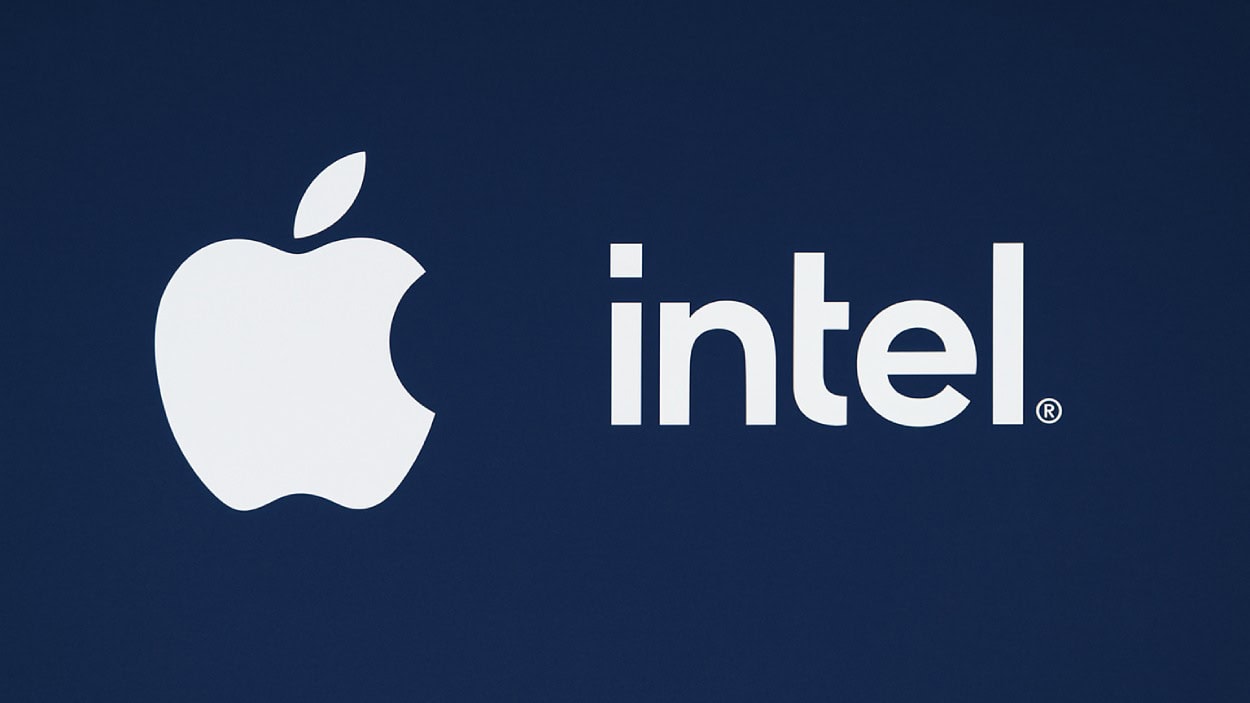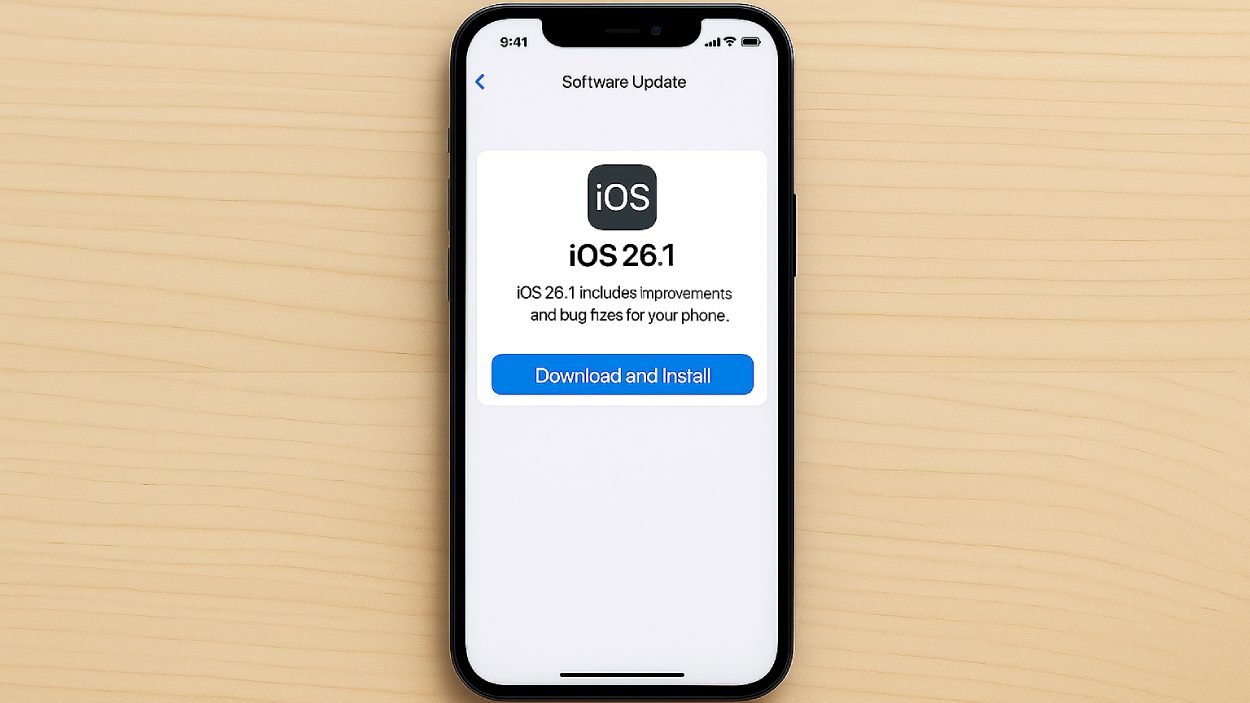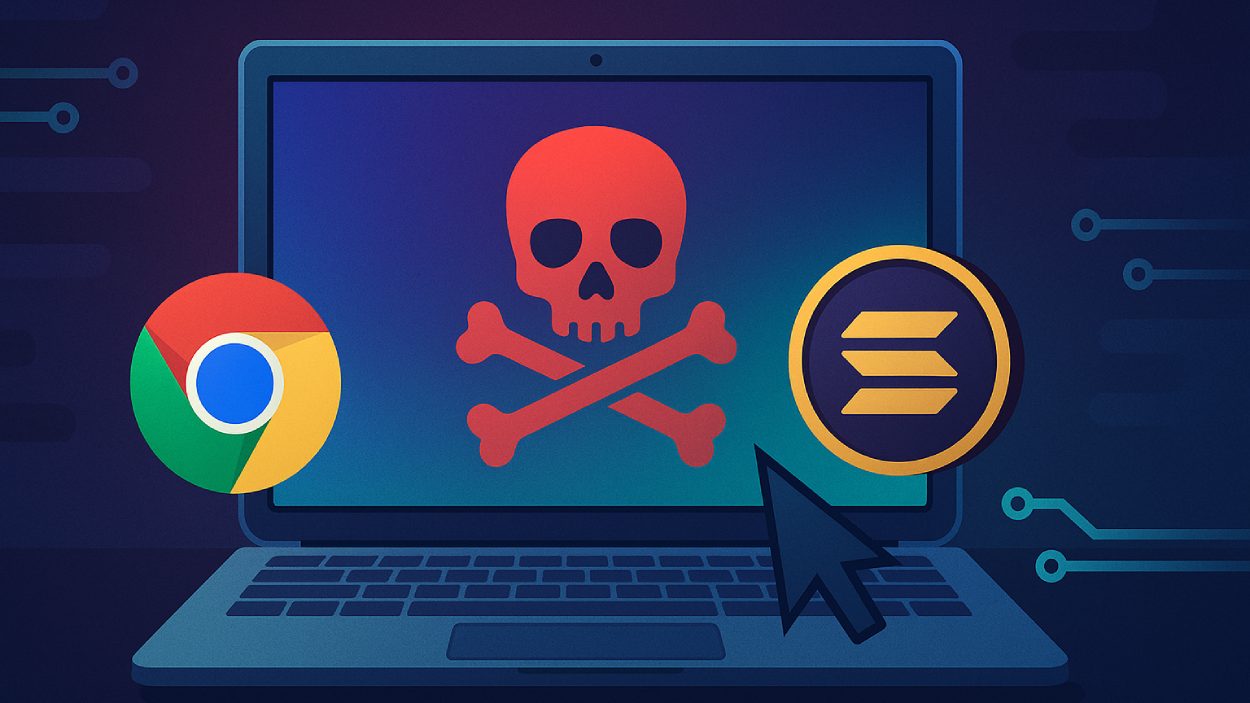In a world dominated by technology giants and proprietary ecosystems, a quiet powerhouse has steadily risen in influence: Linux. What started in 1991 as a hobby project by Linus Torvalds now fuels mission-critical infrastructure, powers millions of devices, and defines the backbone of modern computing. Linux is not just an alternative; it’s often the default. Let’s explore the real numbers behind this open-source phenomenon.
Editor’s Choice
- Linux now powers 49.2% of all cloud workloads globally as of Q2 2025.
- 78.5% of developers worldwide report using Linux either as a primary or secondary OS in 2025.
- 100% of the top 500 supercomputers in the world run on Linux in 2025, continuing a trend that started in 2017.
- The Linux kernel has grown to over 34 million lines of code, with 11,000+ contributors in the last release cycle.
- Linux-based operating systems make up 3.7% of the desktop market share.
- Red Hat Enterprise Linux (RHEL) holds 43.1% of the enterprise Linux server market in 2025.
Global Desktop Operating System Market Share
- Windows remains the dominant desktop OS with a massive 73.72% global market share, making it the primary choice for most users worldwide.
- MacOS holds the second position, capturing 15.33% of the desktop OS market, favored by many creative and professional users.
- Chrome OS accounts for a modest 2.18%, reflecting its popularity in educational and budget-friendly devices.
- Linux secures a 2.09% share, appealing mainly to developers, tech enthusiasts, and open-source communities.
- Other operating systems collectively make up 6.68%, indicating a small but diverse user base for alternative platforms.
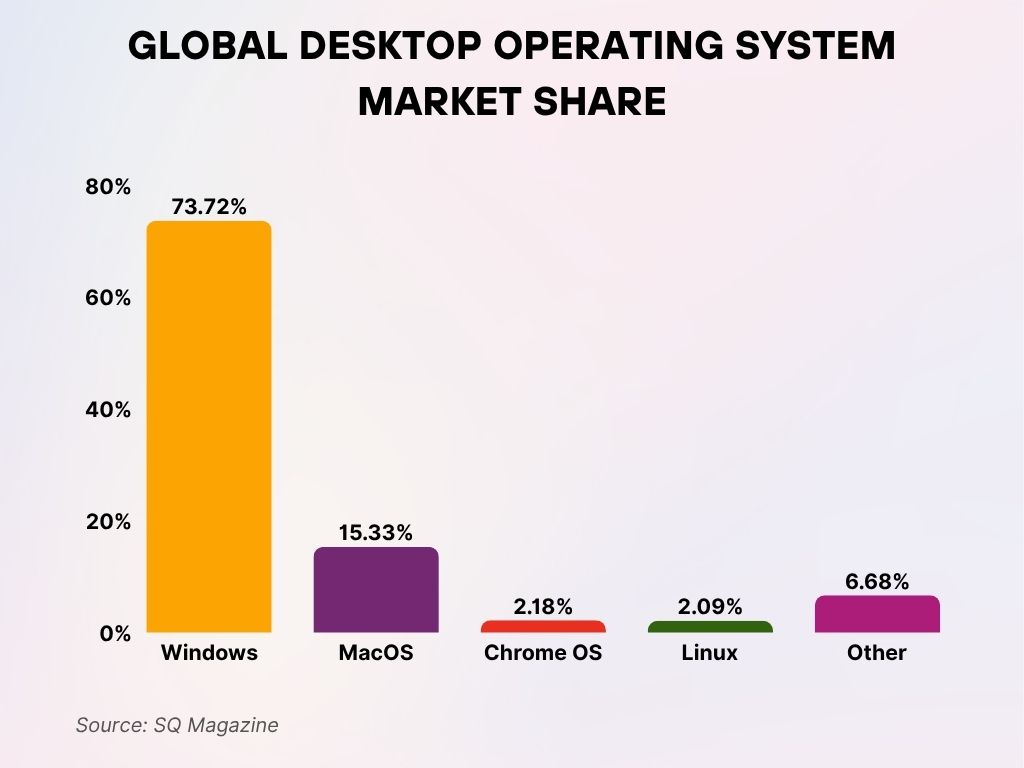
Linux Usage Statistics
- 90.1% of cloud-native developers prefer Linux-based environments for building and deploying apps in 2025.
- 68.2% of DevOps teams use Linux as their primary platform, especially in CI/CD pipelines.
- 53.4% of software development environments worldwide use Linux as the primary OS.
- 87.8% of machine learning workloads run on Linux infrastructure, favored for its flexibility and support.
- 79.1% of professionals in cybersecurity roles use Linux systems for penetration testing and research.
- 74.5% of university-level computer science courses now include Linux as a core teaching platform.
- 27.6 million active Linux users were recorded globally in the first half of 2025.
- 62.7% of IoT developers report building firmware and services atop Linux-based embedded platforms.
Linux Adoption Trends
- Large enterprises adopting Linux as their core OS grew by 9.8% YoY, reaching 61.4% penetration.
- The Linux desktop user base grew by 12.6% in 2025, indicating growing comfort among general users.
- In public sector IT modernization projects, Linux was chosen in 48.9% of migrations from legacy systems.
- Linux container adoption increased by 13.3%, largely driven by the popularity of Kubernetes.
- Education systems in over 31 countries have made Linux-based laptops mandatory for students.
- Linux-based VMs now represent 66.5% of total workloads on hypervisors like VMware and KVM.
- Automotive Linux, particularly in infotainment and ADAS systems, rose to 32.4% adoption in new vehicles.
- Retail businesses report a 45.8% increase in deploying Linux for POS and inventory systems.
Linux Operating System Global Market Growth
- The Linux OS market is projected to grow to $18.73 billion by 2029.
- In 2025, the market size is expected to reach $9.1 billion, showing strong early momentum.
- The market is forecasted to expand at a CAGR of 19.8%, indicating rapid adoption and increased enterprise use.
- By 2026, the market will surpass the $10 billion mark and continue steady growth through 2027 and 2028.
- This upward trend highlights Linux’s rising relevance across servers, enterprise systems, cloud infrastructure, and embedded devices.
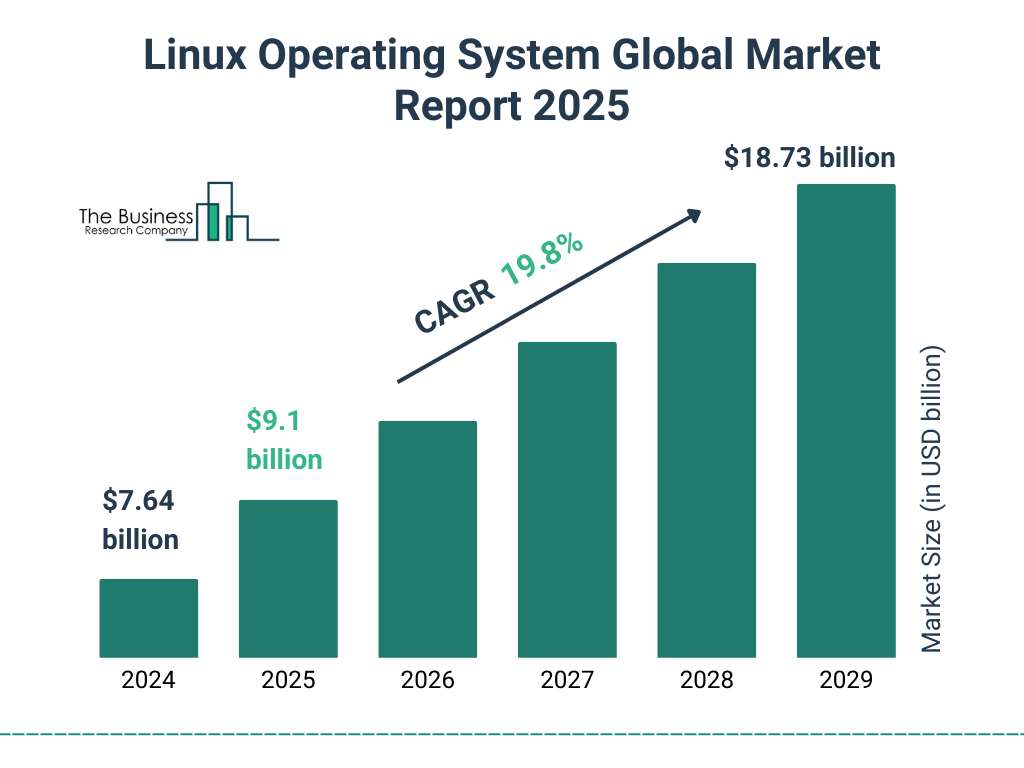
Linux in Server Infrastructure
- Linux powers 78.3% of web-facing servers in 2025, maintaining a strong lead in hosting environments.
- Government data centers worldwide now report 64.9% Linux adoption, citing lower cost and better control.
- Banking and financial services increased their Linux infrastructure footprint by 21.5% YoY.
- Among Fortune 500 companies, 72.6% run mission-critical workloads on Linux.
- Linux is the OS of choice for high-frequency trading systems due to its customization and latency advantages.
- Linux adoption in healthcare data centers stands at 55.4%, driven by secure, HIPAA-compliant distributions.
- Enterprise NAS and SAN storage systems running Linux reached 48.2% in deployment.
- Linux server usage in e-commerce platforms is at 67.8%, notably in backend microservice architecture.
Linux in Cloud Computing
- Linux runs 49.2% of all cloud workloads, showing dominance in IaaS and PaaS layers.
- AWS EC2 instances are 83.5% Linux-based, with Amazon Linux, Ubuntu, and RHEL leading.
- Azure reports a 61.8% Linux VM usage rate among active subscriptions in 2025.
- In Google Cloud, Linux VMs constitute 91.6% of total virtual machine deployments.
- The Cloud Native Computing Foundation (CNCF) notes that 96.4% of production Kubernetes clusters run on Linux.
- SaaS companies use Linux to deploy 78.2% of services due to better DevOps integration.
- OpenStack deployments for private cloud are 87.1% Linux-based in 2025.
- Cloud service providers report an average 15.2% efficiency gain when using Linux vs. proprietary OSes.
Linux Usage in Globally Ranked Websites
- Linux powers 39.2% of all websites worldwide, showcasing its strong presence in the overall web infrastructure.
- Among the top 1 million websites, 45.4% use Linux, indicating higher trust in Linux as site popularity increases.
- Usage climbs to 49.9% in the top 100,000 websites, nearly reaching half of the market in this tier.
- In the top 10,000 websites, 49% rely on Linux, demonstrating consistent dominance in high-performance web hosting.
- For the top 1,000 global websites, 49.4% run on Linux, confirming its reputation for scalability and reliability at the highest levels.
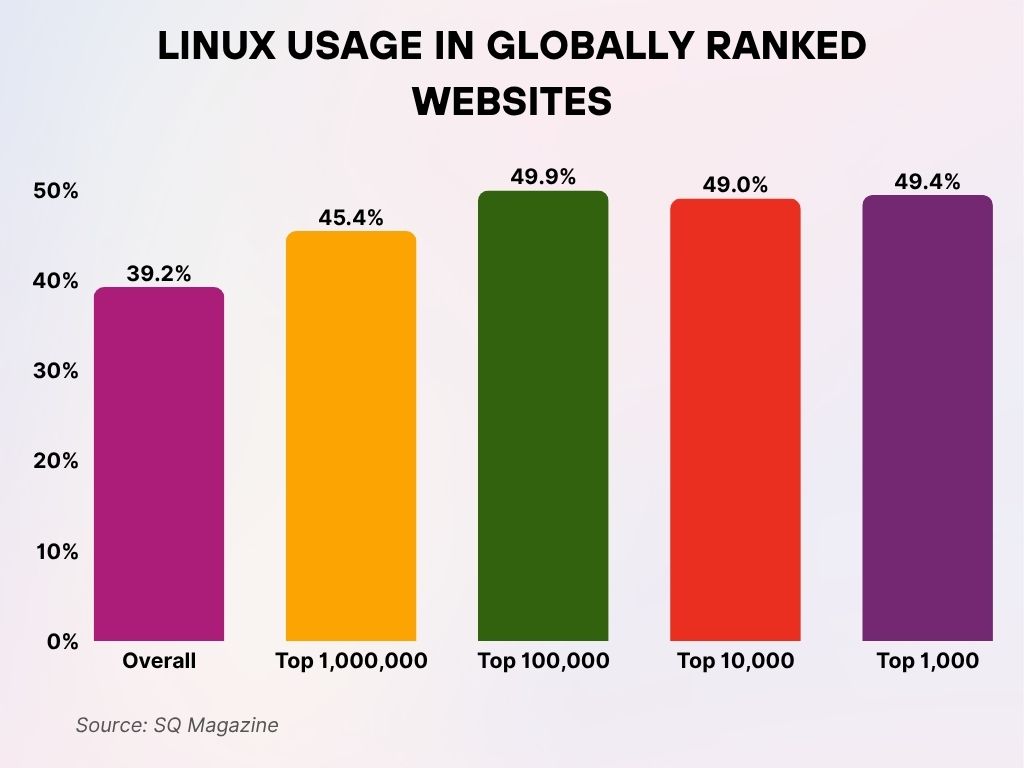
Linux in Mobile Devices
- Android, based on the Linux kernel, powers 70.6% of all smartphones worldwide in 2025.
- LineageOS, a community-maintained Android fork, saw 1.2 million active installs globally.
- PinePhone and Librem 5, open-source Linux smartphones, hold 0.06% of the smartphone market, a niche but growing presence.
- PostmarketOS experienced a 19.4% year-over-year rise in new installations on legacy Android hardware.
- Wear OS, Google’s Linux-based smartwatch OS, powers 34.7% of all smartwatches sold globally.
- Linux-based platforms account for 86.3% of the global tablet market, thanks to Android and ChromeOS hybrids.
- In emerging markets, Android Go (a lightweight Linux-based OS) now runs on 22.6% of budget smartphones.
- Mobile Linux contributions on GitHub rose by 15.2%, reflecting increased developer interest.
- The KaiOS platform (a Linux-based OS for feature phones) maintains 1.4% of the global mobile OS market.
Linux in Supercomputers
- 100% of the Top 500 supercomputers globally run Linux in 2025, a record maintained since 2017.
- The Frontier supercomputer, based in the US, remains the fastest in the world and runs a custom Linux OS.
- Europe’s LUMI supercomputer operates on Cray Linux, optimized for hybrid CPU-GPU workloads.
- China’s Sunway TaihuLight still runs a modified Linux distro, tailored for proprietary architecture.
- Linux is favored in supercomputing for its low-latency kernel optimizations and high modularity.
- 73.2% of HPC institutions cite community support as a key reason for Linux use.
- Scientific simulations, such as climate modeling and genomic analysis, rely on Linux in 96.7% of workloads.
- Linux-powered supercomputers average 25.3% better efficiency in FLOPS per watt compared to proprietary OSes.
- Government-funded HPC labs reported a 15.6% increase in Linux kernel customization in 2025.
Top Linux Distributions by Market Share
- Ubuntu leads all Linux distributions with a 33.9% market share, making it the most widely used Linux OS.
- Debian ranks second with 16%, known for its stability and long-term support.
- CentOS holds 9.3%, favored in server environments before its recent shift to CentOS Stream.
- Other notable distributions include Red Hat (0.8%), Gentoo (0.5%), and Fedora (0.2%).
- Distributions like SuSE, Raspbian, CloudLinux, and several others each account for less than 0.1%.
- A significant 39.1% of systems are categorized under Unknown, indicating the presence of custom or unidentified Linux builds in the market.
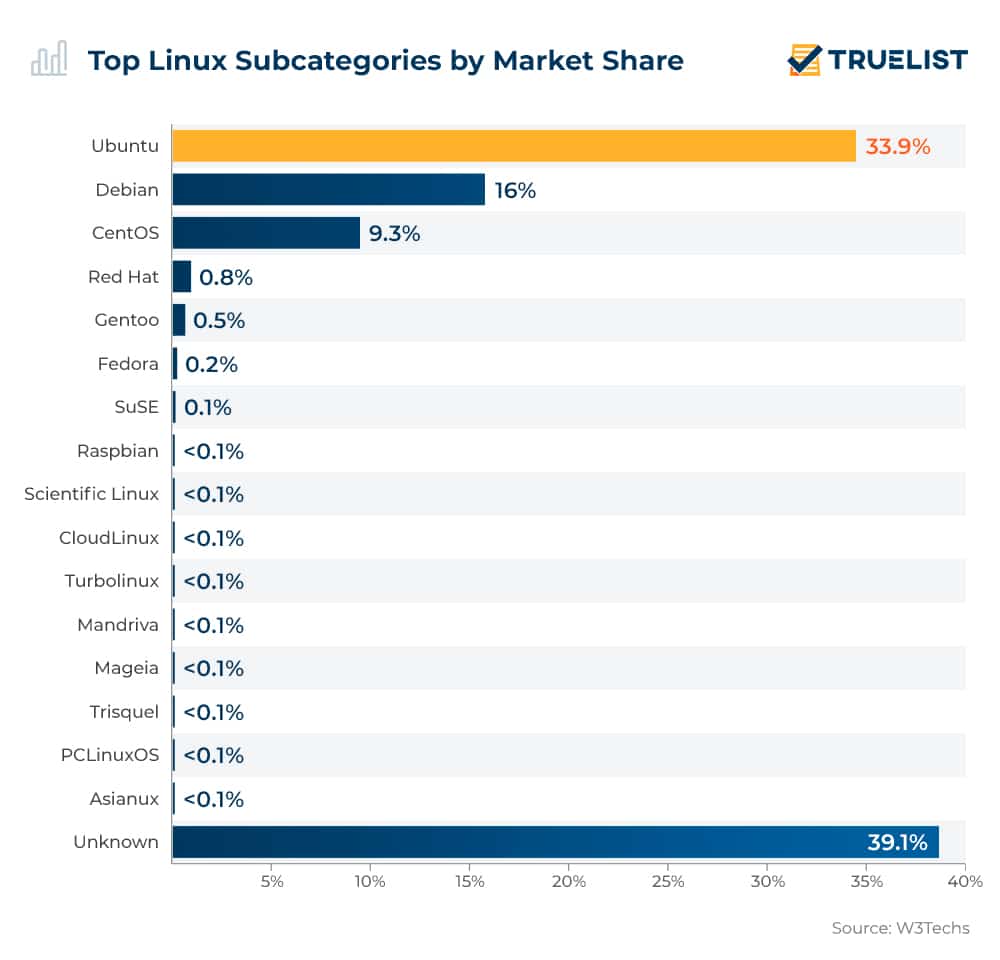
Linux in Embedded Systems and IoT
- Linux runs 39.5% of the embedded systems market, spanning automotive, medical, and consumer electronics.
- Yocto Project-based Linux builds power 27.4% of production-grade embedded products.
- Raspberry Pi OS, a Debian-based Linux variant, reached 10.2 million active devices in 2025.
- In industrial automation, Linux-based PLCs represent 33.1% of new systems deployed this year.
- Smart TVs powered by Linux (like Tizen and webOS) account for 61.3% of global unit sales.
- Automotive Linux solutions like AGL and GENIVI are present in 32.4% of new vehicles globally.
- Linux-based smart home devices, including hubs and thermostats, make up 44.6% of the US market.
- Edge AI devices are predominantly Linux-driven, with 71.9% of edge inference workloads running on Linux.
- OpenWRT, a Linux distro for routers, powers 15.8% of custom home networking setups.
Linux in Enterprise and Business
- 61.4% of large enterprises run at least one mission-critical application on Linux.
- Red Hat Enterprise Linux (RHEL) leads in enterprise deployments with 43.1% market share.
- SUSE Linux Enterprise Server (SLES) gained 11.2%, especially in manufacturing and retail.
- SAP reports that 78.5% of its clients now deploy their applications on Linux systems.
- Linux is used in 58.6% of enterprise databases, especially PostgreSQL and MySQL deployments.
- Linux container orchestration (via Kubernetes) is employed by 72.7% of Fortune 1000 companies.
- Linux on mainframes, especially IBM Z systems, holds 19.3% of global mainframe usage.
- Business-critical ERP and CRM systems, including Oracle and Salesforce backends, run on Linux in 44.2% of cases.
- Linux-based VDI (Virtual Desktop Infrastructure) platforms grew 13.5% YoY among remote-first companies.
Operating System Preferences Among Professional Developers
- Windows is the most used OS by professional developers, with 61% choosing it for their primary development environment.
- Unix/Linux follows closely with 47%, reflecting its popularity for programming, system control, and server-side development.
- MacOS is preferred by 44% of developers, especially in design, mobile app development, and cross-platform environments.
- Other operating systems account for just 1%, indicating minimal usage outside the major three platforms.
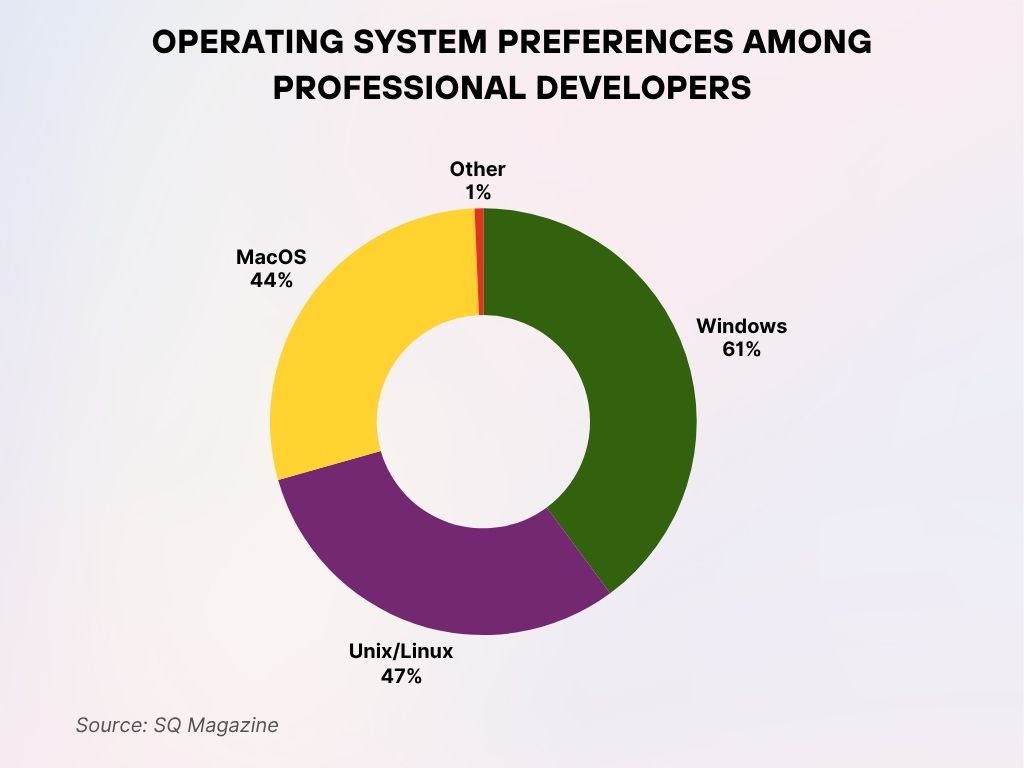
Linux Kernel Development Statistics
- The Linux kernel now contains 34.1 million lines of code, growing by 1.2 million lines since 2024.
- In 2025, there are 11,089 contributors to the Linux kernel across 1,780 organizations.
- Intel and AMD lead contributions, together responsible for 17.4% of commits this year.
- Greg Kroah-Hartman continues to be the most active individual maintainer, with 6,800+ commits in 2025 alone.
- Kernel version 6.10, released in June 2025, introduced native support for RISC-V Vector extensions.
- Git merges related to security hardening increased by 24.6% YoY in the 2025 development cycle.
- Corporate contributions (vs. independent developers) make up 84.3% of kernel commits in 2025.
- 8,321 bugs were reported and resolved in 2025, with an average patch merge time of 5.3 days.
- The Linux Foundation’s Kernel Mentorship Program accepted 207 new mentees globally this year.
Linux in Gaming
- Steam Deck, powered by SteamOS (Arch-based), reached 4.5 million units sold by mid-2025.
- 40.3% of games on Steam are now verified or playable on Linux thanks to Proton and Wine.
- Valve’s Proton compatibility layer added support for 225 new titles in 2025.
- 5.9% of Steam’s monthly active users are on Linux, a historical high.
- Lutris, the open gaming platform for Linux, saw 1.4 million new users join in 2025.
- Vulkan API, widely supported in Linux, is now the default renderer in 72.6% of Linux-native games.
- Game engine support for Linux expanded, with Unity and Unreal Engine 5 offering official Linux editor builds.
- Flatpak game installations increased by 36.8% YoY, driven by accessibility and sandboxing.
- Linux-based handhelds like AYN Odin 2 and OneXPlayer Linux Edition expanded the Linux gaming market by 18.7%.
Linux Website Users by Age Group
- The 25-34 age group makes up the largest share of users at 21.15%, showing strong engagement among younger professionals.
- Users aged 18-24 follow closely at 17.95%, indicating growing interest in Linux among students and early-career tech users.
- The 45-54 age group contributes 17.09%, reflecting solid adoption among experienced IT professionals.
- 35-44 and 55-64 age groups are nearly equal, with 15.33% and 15.45% respectively, showing balanced mid-career usage.
- Seniors aged 65+ account for 13.02%, representing a smaller but notable portion of the Linux user base.
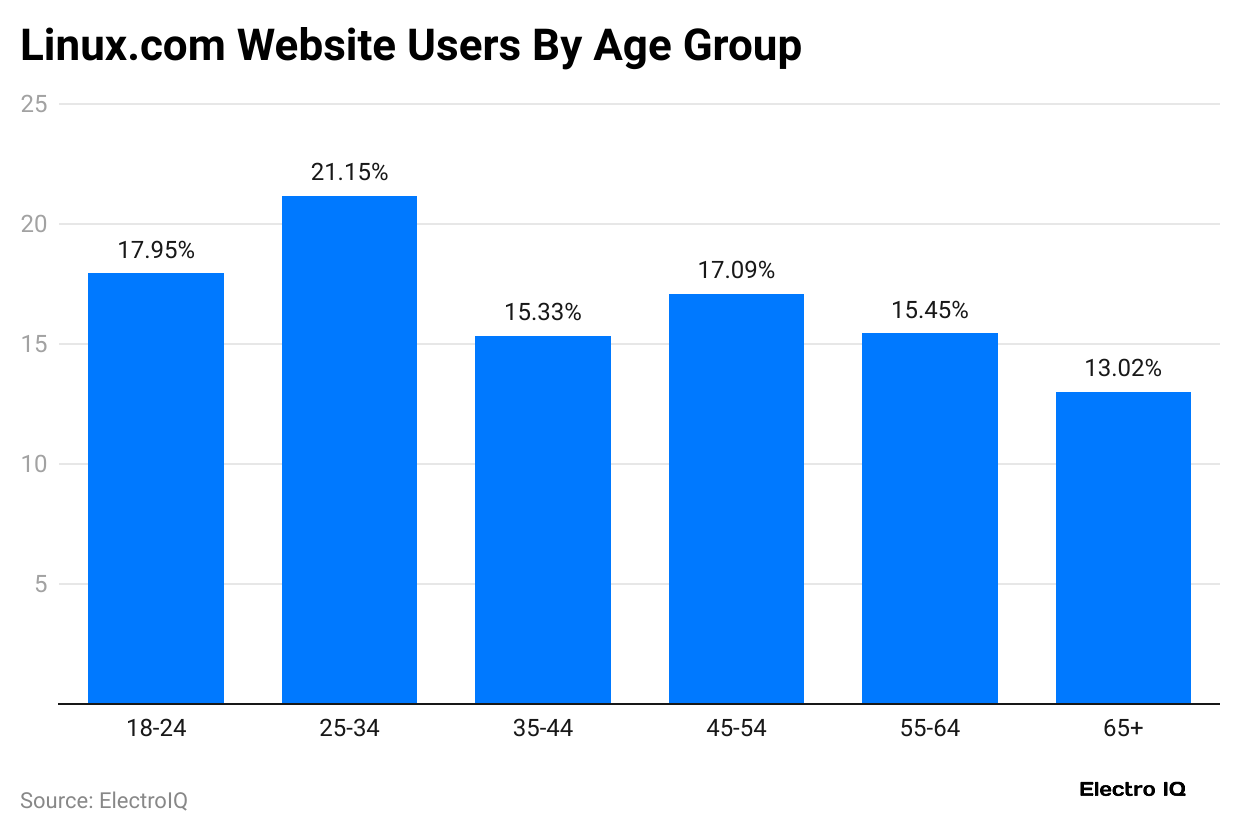
Security Statistics
- CVEs (Common Vulnerabilities and Exposures) reported for Linux kernel in 2025: 648.
- SELinux and AppArmor are actively enforced in 55.6% of enterprise Linux environments.
- Kernel live patching usage rose to 31.5%, reducing server reboot downtime during updates.
- Auditd and syslog-ng adoption for Linux logging increased by 23.3% across security-conscious industries.
- Linux malware detections accounted for only 1.3% of all OS-targeted malware reported in 2025.
- Two-factor authentication is enabled on 72.1% of Linux-based servers, especially SSH endpoints.
- FirewallD and UFW were active on 88.4% of home and small-business Linux installations.
- Security updates are applied automatically on 47.9% of Linux desktop systems.
- Linux Foundation’s OpenSSF expanded its funding by 19.4% to strengthen open-source software security.
- Rootkit detections decreased by 11.6%, attributed to hardened kernels and better anomaly detection tools.
Social Media and Community Statistics
- The r/linux subreddit grew to 1.75 million members, with a 12.6% rise in engagement over 2024.
- Linux Twitter (X) hashtags such as #Linux and #FOSS were used 4.2 million times in the first half of 2025.
- The Linux Foundation’s YouTube channel reached 481,000 subscribers, up 17.3% YoY.
- Matrix.org and Discord Linux servers combined saw 26.5% more developer-led discussions.
- Fediverse platforms like Mastodon host 89.2K+ active Linux-focused accounts in 2025.
- Over 134,000 contributors starred or forked Linux-related projects on GitHub this year.
- The Arch Linux Wiki recorded over 20 million unique page views in 2025.
- LinuxFest Northwest 2025 welcomed over 7,600 attendees.
- Open Source Summit North America featured 410 Linux-centric talks, workshops, and keynotes.
Linux Website Traffic by Country
- The United States leads all countries, contributing 16.93% of the total traffic to Linux.com.
- India ranks second with 4.67%, reflecting a growing developer and open-source user base.
- Brazil follows with 3.97%, showing strong interest in Linux across South America.
- Both Switzerland and Germany account for 3.66%, indicating steady usage in Central Europe.
- A large portion, 67.11%, of website traffic comes from Other countries, highlighting Linux’s widespread global reach beyond the top five.
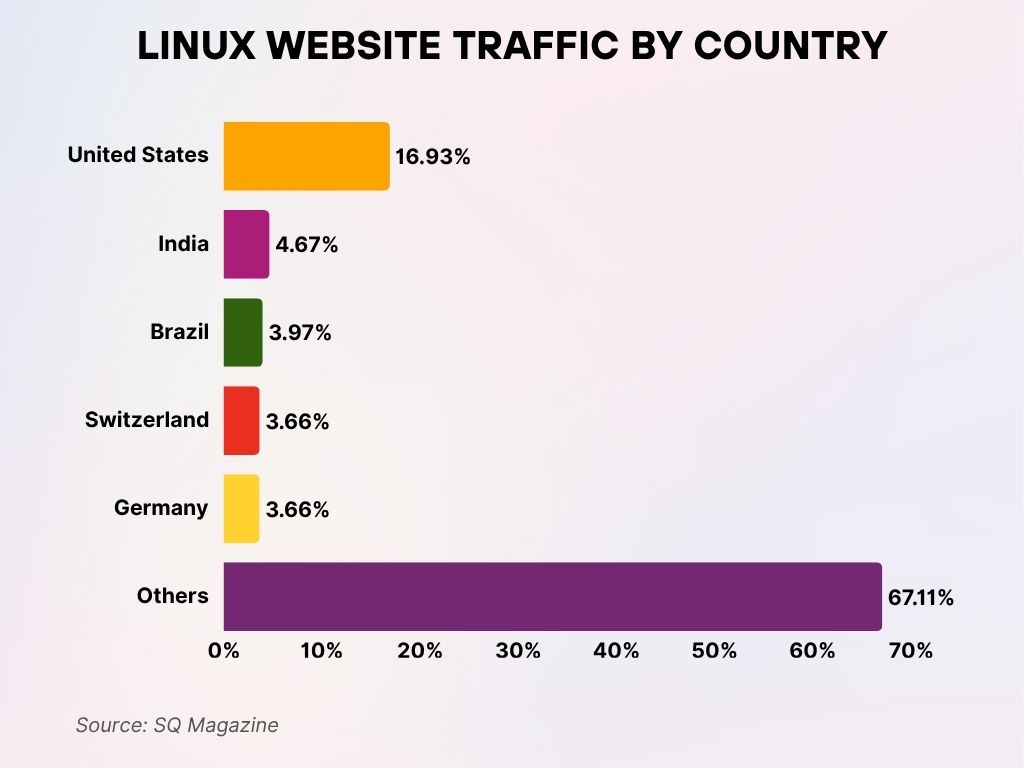
Recent Developments
- Linux kernel 6.10 was released in June 2025 with expanded support for Wi-Fi 7 and NVMe 2.0.
- Systemd v256 introduced significant boot time improvements, reducing average startup by 18.4%.
- Wayland adoption outpaced X11 for the first time, now the default in 52.7% of Linux desktop environments.
- Canonical announced Ubuntu’s full integration with ZFS on root as a default install option.
- RHEL 10 beta launched with enhancements in real-time kernel and FIPS-certified cryptography.
- Linux Mint 22, codenamed “Sycamore,” added native support for Flathub integration and power profiles.
- OpenSUSE Leap Micro gained traction as a lightweight, immutable OS, growing by 11.6% in deployment.
- Purism released Librem 6 dev kits, a privacy-focused Linux smartphone platform.
- Valve and KDE collaborated on optimizations for Plasma Desktop on SteamOS.
- Git 2.47 shipped with performance boosts and a new Linux-native rebase engine.
Conclusion
In 2025, Linux isn’t just surviving, it’s leading. From servers to supercomputers, from smartphones to edge devices, Linux continues to be the operating system of choice for developers, enterprises, governments, and curious users alike. Its unmatched flexibility, robust security, and community-driven innovation position it not just as a cost-saving alternative, but a strategic technological foundation. As open-source culture grows stronger, Linux’s role in shaping the digital future becomes undeniable.









